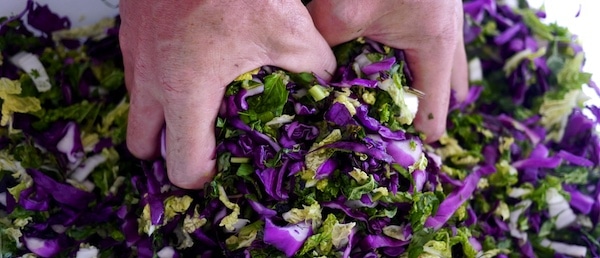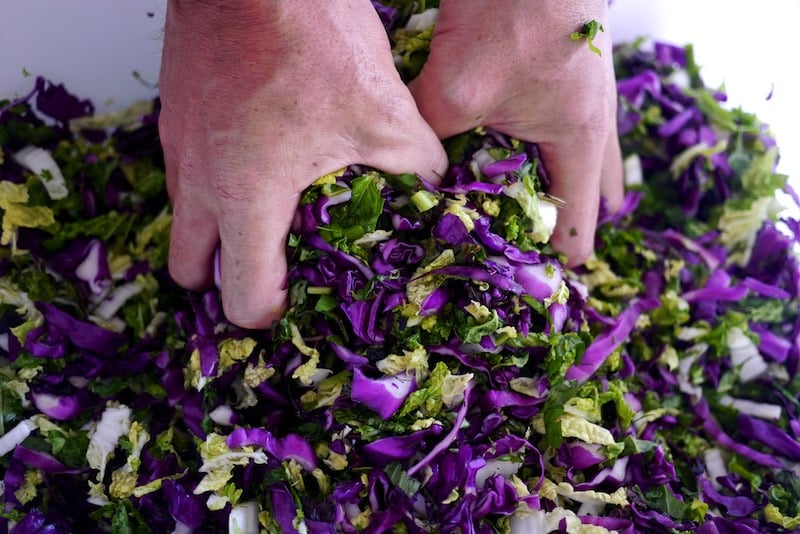

Sauerkraut has become a primary cog in the engine of our kitchen. We eat it hot, we eat it cold. On eggs, in soups, and on the side. You can make it with whatever you’ve got. Or nearly.
So of course there’s traditional sauerkraut, which is made from just cabbage, i.e. kraut. And it is deee-licious.
However, cabbages are not always at hand throughout the four seasons, or not where we live, anyway.
So, in the interests of keeping things as local, seasonal and fresh as possible, we now kraut whatever we can.
The basic parameters are thus: if it’s vegetable, and squeezable, it’s suitable. Keep the slices thin, find a balance between vegetables that will stay crunchy and those that will go soft, and off you go.
This batch below was thinly sliced red cabbage, wombok cabbage, amaranth, big bunches of dill + basil, and grated carrot. Here’s how to do it:
Simple Mixed Kraut
- 5kg mixed veg (or however many kilos you have)
- 1 1/2 Tablespoons of good quality salt per 1kg of vegetables
- Favourite herbs and or spices
- Big tub or bowl for krauting in
- Strong hands
- Your favourite knife + chopping board, plus a grater if you like
- A fermentation crock, or bucket or big jar with lid
Ok here we go. After washing all your veg well and weighing it so you know how much salt to use, slice everything thinly. Or, leave it chunky – up to you. but the thinner everything is, the easier it is to extract the juices.
Put all your sliced veggies, herbs + 1 tablespoon of salt per kilo of veg into a big tub or bowl, wash your hands, and start squeezing. Funky music helps here.
Squeeze. And squeeze some more. The object here is to bruise the vegetables so that their juices are macerated out of them, with the help of the salt.
Some people punch, some squeeze, some rub. Some use a flat ended rolling pin, or a sturdy bottle. Whatever works for you is fine – but keep squeezing that veg until it’s swimming in juice.
How to tell when it’s ready: when you can pick up a handful of the veg and, by squeezing, get a good dribble of juice to come out, you’re there.
Now for the packing.
Take your jar, fermentation crock, bucket or whatever you’re going to do the fermentation part of the krauting in, and start packing in handfuls of your kraut. Bashing it down with a masher of some kind as you go is a good idea. We use our rolling pin for this bit.
At the end of packing, you should be able to press all the kraut below the juice easily. This is good. That briney juice is what is going to help ferment your kraut.
Its important to, if possible, keep the veg below the brine from here on in. You can use krauting weights for this, or a ziplock bag of water, or a nicely fitting rock, or similar.
The wonderful Sandor Katz uses a cabbage leaf with a chunk of carrot or other veg ontop, which wedges between the kraut and the lid of the jar to keep everything submerged.
The thing is that you do want a seal on your vessel during this process. You want the kraut to ferment with the wild yeasts that are inherent to the vegetables, not with other biology from the outside world. So make sure whatever vessel you use can be sealed reasonably well.
Well done. Wash your hands, and keep your kraut nearby for the next 7-14 days.
Burping your kraut
As your kraut ferments, it will release gasses. This is a good sign that all is well. Depending on your fermentation vessel, you may need to burp your kraut daily to release these gasses.
If your kraut is in a crock, the lip has a funky water based airlock which allows the kraut to self-burp, as it were. There’s other systems with other types of airlocks too.
But if you’re just working with a jar or similar, opening the lid once or twice a day to let the gasses out is fine. Burp.
When your kraut is done
The best way to tell when your kraut is done is to taste it. Some people like it after 7 days, some after 14, some people leave it for months and months. So, taste it as you go. Learn what you like.
Once your kraut tastes great and as sour as you like it (we generally go with 14 days-ish, depending on the weather, and the flavours in the kraut), get it into your fridge, or cold store.
This will slow the fermentation down to not much, and from here on in your main task is eating it.
And there you go. Share it with friends, eat it all the time, enjoy the benefits of a healthy gut and a tasty platter.
Have you tried a big spoonful of kraut in pumpkin or potato + leek soup? You should. It’s the business.

Kraut combos we love
- Rainbow chard, wombok, fennel, carrot, basil, collards + cumin seed.
- Carrot, fennel + orange.
- Red cabbage + caraway.
- Green cabbage, mustard greens, chilli.
All our articles on Food + Fermentation are here…
Big thanks to: Sandor Katz for getting us krauting, Fiona from Buena Vista Farm for her shut-the-door red cabbage + caraway kraut, Linda from Grow Farm Forage for growing such great veggies that make us want to kraut them, and Gillian from Cultured Artisans for crazy beautiful flavour combos.













Just wondering whether warming, cooking sauerkraut, would destroy the enzymes and probiotics in it.
If you boiled it (mind you, there’s plenty boiled sauerkraut recipes) you do kill all the microbiology of the ferment – but plonking it in some soup, or heating it to warm, most of the good stuff will still be there 🙂
I have found that using a fermentation air lock works very well for making Kraut, it auto “burps” and prevents the introduction of oxygen during the ferment. This eliminates the bacterial “slime” formation that tends to form in a ring around the ferment top layer when oxygen is introduced by burping.
On a second note, using various mixed exotic salts like Himalayan pink salt, Hawaiian black salt and various sea salts introduces a broad range of trace minerals that activates the enzymes and greatly improves the health benifits.
yep an airlock is great if you have one, but if you don’t , we find manual burping is fine 🙂
I have been making mine in quart jars, a couple at a time. I haven’t been very adventurous, nothing beyond adding grated carrots and a few fennel seeds. Someone asked about boiling. Not going to address that but I have seen that it can be frozen without killing the good stuff. It does take a little time for it to “wake up” again. Thanks for this article. I would like to try out some new combos.
On my list of things to try – Orange and Fennel is a flavour combo I like but I wondered – the whole orange sliced? just the juice? Just the zest? Thanks! I have your lovely book but its at home & I’m not..
Whole slices chopped into bits – that would be my go-to. Or you could just do chopped peel if you like? 🙂
Thanks for the recipe! This is my go to, have been making it for a year or so and it’s always delish 🙂
awesome 🙂
Good Day! We have many – Cauliflower – Broccoli – Brussel Sprouts and Cabbage that did not form this year… I did not want to see our efforts go to waste so I researched for a way to make use of these leaves and I hope that this site will assist me… I will add to this over the next few months to let everyone know whether it is a success…
Best of luck 🙂
Hiya, I’ve just made some kraut. I put 2 tablespoons of salt to 1 kilo of Veg as per recipe list of ingredients ..but then read later on that it says 1 tablespoon of salt per kilo. Anyone I’m thinking that’s ok it might just be a bit salty this first lot.
Just the info I was looking for. Has anyone used silverbeet leaves for sauerkraut?
You can, but I would say use sparingly – they can be a bit sludgy when they’re the main green in a kraut. A bit is fine, tho!